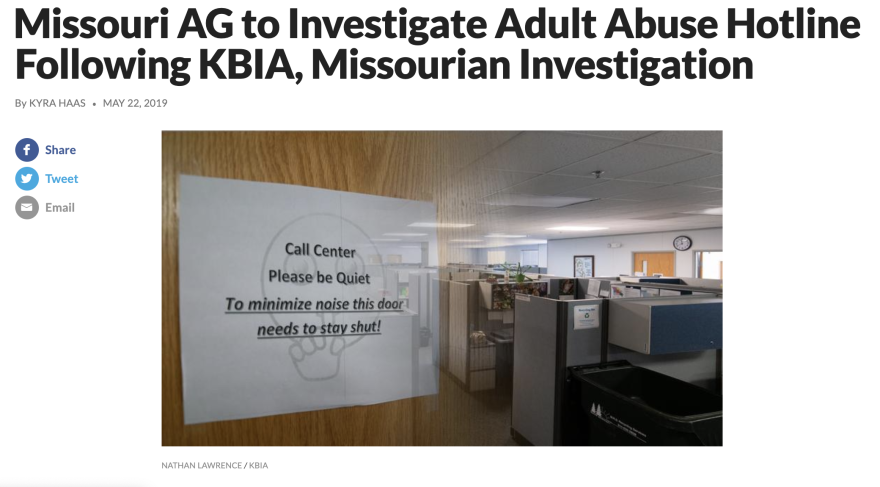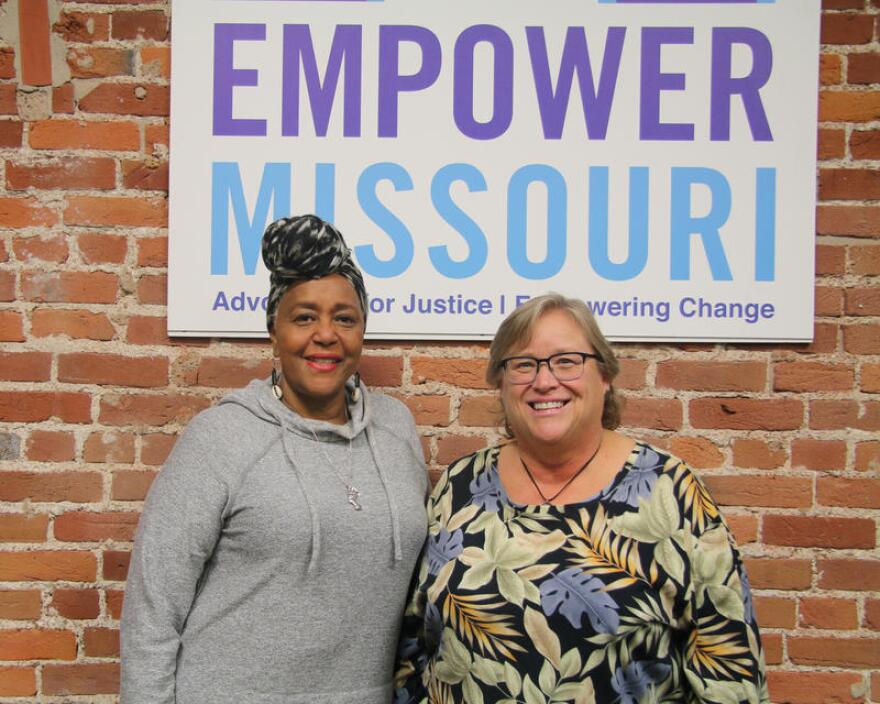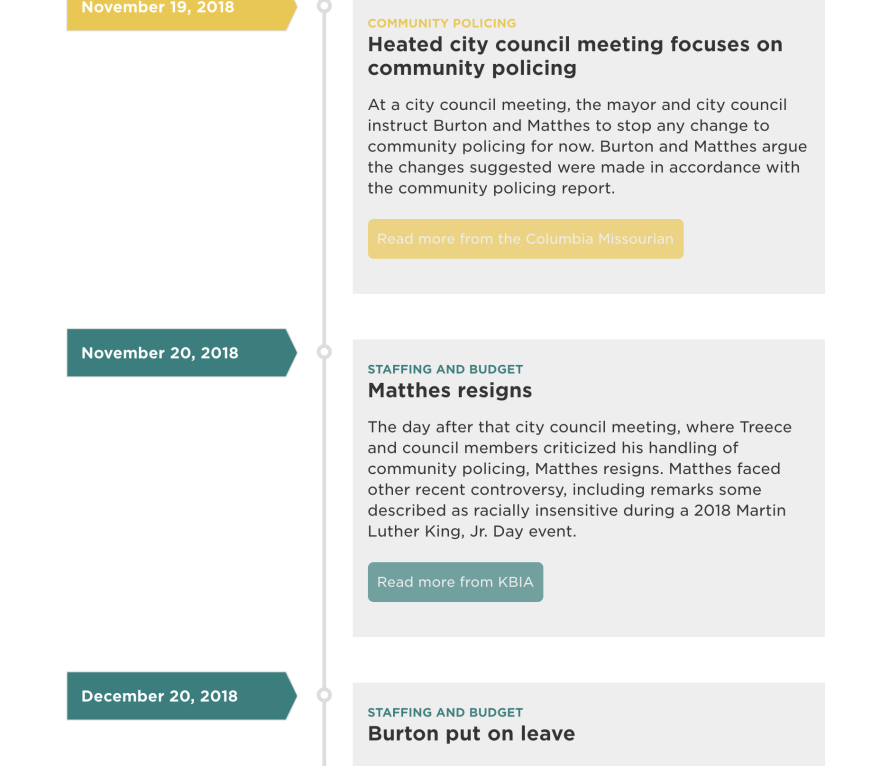This is the audio that makes up the submission for this category:
Below you will see time codes to denote where you will hear which stories in the audio, with links to the original stories posted online, and descriptions of the station's work where appropriate. Some of the pieces are segments of the larger stories, in order to provide more examples of our work in this competition. Edits are noted in each description, and there has been no internal editing. You will hear short beeps to denote the separation between pieces.
(0:00 – 1:35) Full Newscast, May 23, 8:06 AM
(1:35 – 7:34) Thousands Call Missouri’s Adult Abuse Hotline, But Only Some Get Through
As you’ll hear in this story, KBIA’s joint investigation with the Columbia Missourian found only about 40 percent of calls made to Missouri’s Elder Abuse Hotline from January through April 2019 were answered by someone who could file a report. The hotline collects reports of abuse, neglect and exploitation of those 60 and older as well as disabled adults under 60. Calls that went unconnected were often dropped for various reasons including a hold limit or people simply hanging up after an extended wait time.
Within hours of publishing this story, the Missouri Attorney General’s office issued a press release announcing an impending investigation, citing this reporting. Here is our follow-up explaining the AG’s move.

The reporters, Kyra Haas and Aviva Okeson-Haberman began looking into the story idea in late fall 2018. Early in the process, a Missouri resident told Okeson-Haberman she had called the hotline 11 times over a day and a half and waited on hold for a total of two hours before finally connecting. A Missouri Sunshine Law request painted a much darker picture of calls that were getting answered.
The story continues to develop, with the most notable recent development being that the AG’s office recommended seven changes. That includes a new online reporting system in order to address the thousands of unanswered calls to the state’s hotline, as well as redirecting callers who are simply looking for information about local resources — not calling to report abuse. Here is a follow-up story on that action.
(7:35 – 8:48) Columbia Planned Parenthood Officials Respond to Potential Statewide Abortion Halt
(8:49 – 10:56) Listen: How People in Jefferson City Experienced a Major Tornado and its Aftermath

This “audio postcard” aired in the afternoon, about 15 hours after the tornado hit. It aired a few minutes after another report with the basic information and comments from local officials.
(Note: the original piece was 3:40 long, the last 1:30 edited off for time)
(10:57 – 14:52) Sights and Sounds From Mid-Missouri’s Election Watch Parties
KBIA aired an 8-minute long wrap up of our coverage of the municipal election, the morning after election day.

(Note: The last 4 minutes of the piece edited off for time)
(14:54 – 18:43) Amid Opioid Crisis, Advocates Push for Monitoring Tool Every Other State Has
(18:44 -22:43) How Missouri’s Senate Passed a Restrictive Abortion Bill Overnight
This story aired just a few hours after the bill passed, and was part of Aviva Okeson-Haberman’s continuing coverage of this bill throughout the 2019 Missouri Legislative Session
(22:44 – 27:26) After Semester of Tumult, Columbia Parents and Officials Still at Odds Over Police in Schools
(Note: this is a 5 minute segment of an 8-minute long piece. 2 minutes were cut from the beginning of the piece, and 1 minute of the end).
(27:27 - 31:02) Show Me the State: The Gay Purge

“Show Me The State” is our new KBIA show that launched in 2019. It explores the misunderstood folklore and fables of Missouri’s history. In each episode, we try to figure out what the real story was, what the political and cultural context was at the time and how that has shaped the state today. It is an ambitious show, adopting a narrative structure that is very labor-intensive. Each episode is produced over a 3-6 month period. We released 10 episodes in 2019. The show is launched primarily as a podcast, though they also air on our traditional broadcast. You can see the full list of episodes here.
Note: This is a 4 minute segment pulled from a 29-minute long episode of the show (what you’ll hear is what aired on KBIA during Morning Edition and All Things Considered to promote the program).
(31:03 - 35:03) Intersection: Why it’s Tough to Talk About Sexual Violence
Intersection is KBIA’s weekly local issues talk show, which covers a wide breadth of topics. You can view the other programs here.
Note: This is a 4 minute long segment from a 29 minute long program edited for time for the purposes of the competition.
(35:04 - 38:42) Missouri Health Talks: HIV Prevention Medication ‘It’s Not Being Rolled Out Equally for Women’

“Missouri Health Talks” is an on-going series at KBIA, a local NPR member station in Columbia, Missouri. It strives to assist Missourians from throughout the state in sharing their own experiences about access to health care in their own voices. This is one example of the pieces produced this year.
The project is an example of what we call “conversation-based journalism,” where producer Rebecca Smith finds everyday people from throughout the state, especially in the more rural areas, and has them chose a person in their own life to have a conversation with about access to care. It is, of course, loosely modeled after StoryCorps, but focused on a specific beat and geographic region.
These 45-minute conversations are then edited into four-minute features that air weekly on KBIA. In its first year and a half, the project has covered topics that include organ transplantation, homelessness, domestic and sexual violence, disability and more.

The purpose of the project is to allow sources the room to have conversations about the ways in which access to health care impacts their lives. One of the particular focuses of this project is to make sure that diverse voices are brought to the forefront, be they diverse geographically or in terms of gender, ability or identity. For example, one of the stories in our submission includes a source who is on the autism spectrum, who would rarely be included in our on-air coverage otherwise.
Particularly in this time, when trust in media outlets is at all-time lows, we believe giving our sources the agency to tell their own stories helps us build trust and connection with both our sources and audience.
This content plays well on the air, but when considering how to feature the content online, KBIA decided to create a completely new interface that would deliver the stories in the most optimal ways. Each story has a visual component, and is manually sorted and tagged in a way that allows for each navigation and discovery of other stories a user may be interested in based on topic or geographical area. The project also aspires to reach rural areas across the state, so a mapping feature has also been created as a primary element of the presentation. KBIA Digital Content Director Nathan Lawrence designed and built this interface himself. These stories have consistently been among the most viewed and shared since the creation of this project.
Note: The anchor tag was edited off for the sake of time.
(38:43 – 41:34) The True/False Podcast: Musicality with Morgan Neville

The True/False Podcast is a true collaboration with the renown True/False Film Fest in Columbia, MO. Programmers from the festival interview filmmakers about the art and craft of documentary filmmaking, while producers at KBIA handle pre and post-production. In 2019 the podcast featured interviews with numerous Oscar winning and nominated directors, including Morgan Neville. Neville spoke about his documentary film about Fred Rogers, “Won’t You Be My Neighbor,” which had just become the highest-grossing biographical documentary ever produced. The show is produced primarily as a podcast. While some segments air on KBIA, its primary audience is online and mobile audiences. You can view the full list of episodes here.
(Note: This is just 3 minutes of a 24-minute long episode, edited for time).
The contest description also asked that we include evidence of digital-based content. Here are a few examples:
Access Missouri:
KBIA news director Ryan Famuliner is the founder and creator of Access Missouri. Famuliner collaborated with the MU Informatics Institute and the MU political science department to create the site originally, and the most recent development has been exclusively been done by KBIA Digital Content Director Nathan Lawrence.

In Missouri, there is a significant amount of information about the state legislature that is almost completely unsearchable on state government sites, because of the way it is stored – almost exclusively on .pdfs as daily journals. Before this project, getting comprehensive information on basic legislative action - a legislator’s voting records, attendance, bill sponsorship information, etc. - required hours of research spent poring through these documents.
There is significant need for awareness of the flow of money in Missouri state politics, and for the press and public to serve as watchdogs. This project opens up that information, creating a whole new level of transparency to the public. It also provides profile pages for group and individual donors, letting users track Missouri’s political donations by influencer instead of just by gift, something that normally requires extensive manual labor.
This allows KBIA to inform Missourians in ways that would never be possible in the traditional audio medium. Numbers are terrible for radio stories, and there’s almost no opportunity for self-driven discovery in our traditional medium. This project allows audience members to ask their own questions of the data and find their own answers. The project also seeks to inform the reporting of other news outlets in the state. Numerous television and radio stations and newspapers have formally incorporated Access Missouri into their election coverage by embedding the site as a whole on their website, or by pulling specific data into their coverage using the “embed” function you will see on many of the pages if you navigate through the site.
Development of the Access Missouri continues, and developers have been sharing information with reporters interested in launching similar projects in other states. We have received grant support for this project from multiple entities, including the Knight Foundation Prototype Fund and the Reynolds Journalism Institute. There are many features that could be added in the future as well, including effectiveness ratings and ideology scores for legislators, neural network-based bill labeling and categorization, automated news writing tools and other advanced analysis tools.
Ken Burton Timeline:

Former Columbia Police Chief Ken Burton left the department in January, following a tumultuous last few months in which he received scrutiny from many different groups in the community. Tumult was a common theme of Burton’s time as police chief, which started when he came into the job in 2009 with the stated intent of being a reformer. With that in mind, KBIA News wanted to create a timeline of key events in Burton’s work.
KBIA staff members teamed up and spent 2 days compiling coverage from several news outlets in Mid-Missouri and included links to their original stories. Meantime, KBIA Digital Content Director Nathan Lawrence identified and modified the tools we’d need to display them in a way that would be useful in helping our audience understand the key points in Burton’s tenure that got us to where we were.
To support the large amount of time-bound information our reporters and editors had gathered, we turned to a custom digital solution that bound short timeline entries to the user's vertical scrolling instead of trapping them in a small horizontal window like most open-source timeline plugins you see in newsroom projects.
How People in Jefferson City Experienced a Major Tornado and its Aftermath:
View the social media video here
Audiograms:

In 2016 KBIA’s Nathan Lawrence created what is now called an “audiogram,” animated waveforms that accompany short audio files so they can be shared on Twitter and Facebook. The solution to creating these that we pioneered uses After Effects expressions and scripts, and has been adopted by scores of other news outlets across the country. We continue to use these and improve them; here are examples of how we use them for different projects and shows at KBIA:
Podcastle:
The tool that displays our podcasts, as you see here for Show Me the State, is a unique tool built by KBIA’s Nathan Lawrence. He wanted to create an interface that was less cluttered and complicated than our website, but also allowed for more content (like photos or videos) than third party podcast distributor pages (iTunes, Stitcher, etc). He calls the tool “Podcastle,” and has developed it as an open-source project, wanting to share his work with any others that can utilize it. This is the link to the GitHub page for this tool.
Helping Other Stations:
KBIA open sources a great deal of its original news development work for other radio stations and news outlets to adapt. Examples of KBIA’s open source projects that have been used by other stations or news outlets include iFramer, a tool that lets users manage and post non-iframe embed codes where script tags are not allowed; CP Toolkit, a set of tools for helping stations deal with NPR's CMS Core Publisher; Lede; a React-based set of components designed for visual presentation of news; and Velour, a LESS-based CSS framework and mixin set designed to extend Twitter’s Bootstrap CSS framework with simple and tasteful animation

